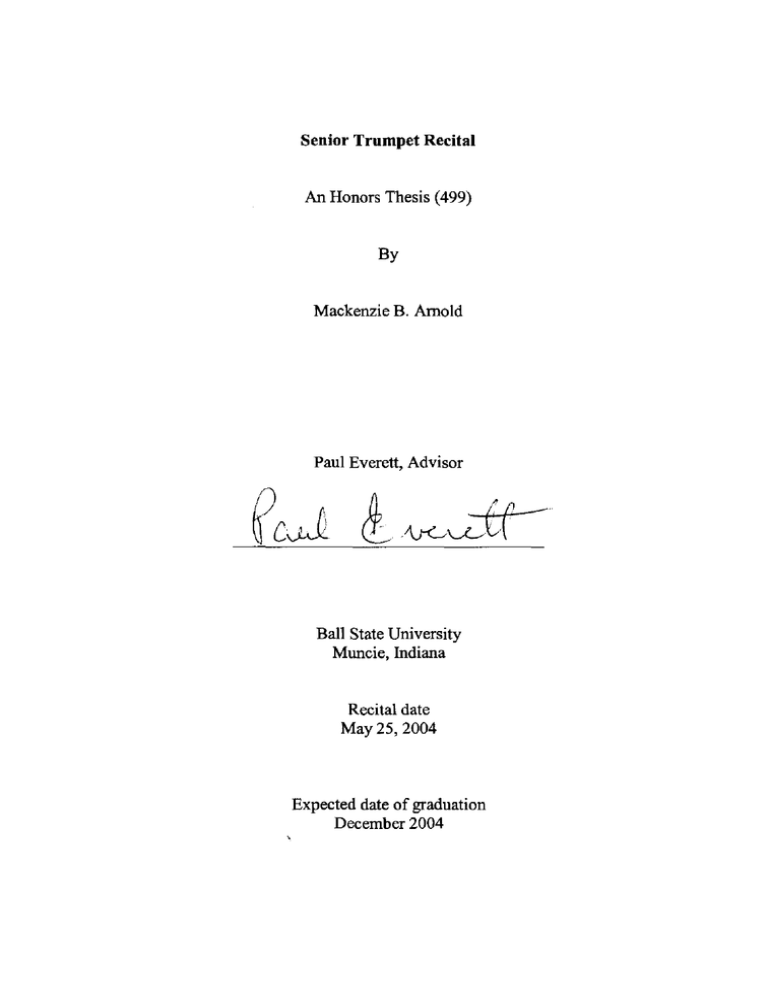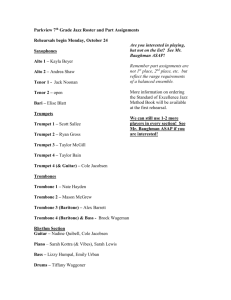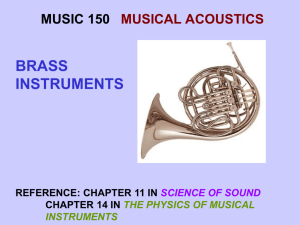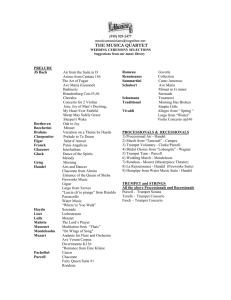Senior Trumpet Recital Paul
advertisement

Senior Trumpet Recital An Honors Thesis (499) By Mackenzie B. Arnold Paul Everett, Advisor Ball State University Muncie, Indiana Recital date May2S,2004 Expected date of graduation December 2004 Abstract It has been the love of music and the desire of trumpet playing that has brought me to this point in my life. This recital will include five pieces that represent a passion for brass instruments and great literature written for trumpet and brass quintet. The following program notes give information about the composers and their pieces, which I have selected to perform. In this recital, I performed the first and second solo pieces on a c-trumpet. I played the third solo piece on a b-flat trumpet and the fourth piece on an f-alto trumpet. I performed the final piece along with a brass quintet that consists of two b-flat trumpets, and one French hom, trombone, and tuba. The first piece on the recital is Concert Etude, by Alexander Goedicke. I chose to perform this piece because he helped to refine my articulation skills by requiring the double tonguing technique. The second piece is Knudage Riisager's Trumpet Concertino, Op. 29. This three-movement piece challenged my endurance as well as my articulation skills. While double tonguing is not required for this piece, extensive single tonguing was required. Petite Piece Concertante, by Guillaume Balay, is the third piece on the program. I really enjoyed this piece because it not only requires the technical skills of fingerings and articulations, but it also requires a certain level oflyrical playing abilities. The contrast between lyrical and technical trumpet playing can be found in this piece. Following the intermission, I performed Richard Strauss' First Hom Concerto in E-flat Major. This piece is a standard in the French hom repertoire, as well as one of my very favorite pieces to listen to. I liked it so much that I pursued it in performance on the F-alto trumpet. The final piece is Thorn Ritter-George's Brass Quintet No.3. As with the hom concerto, great brass literature can be found for each instrument as well as a group of instruments. This piece is just as enjoyable to playas it is to listen to. I chose to perform this piece with a brass quintet to display the other members of the brass family. Acknowledgements Paul Everett, my trumpet teacher and advisor, for inspiring me to become a better trumpet player than I thought I could ever be. Jiyong Jyong, for her awesome piano abilities and for accompanying me in this recital. The Mid-America Brass Quintet, for being so kind to perform in my recital. My family, for always being there to help guide and support me in my decisions and ambitions. This recital is for you. Mackenzie Arnold Senior Trumpet Recital Program Notes Alexander Goedicke was regarded as the guardian of strict classical traditions in Russian music. His music is also notable for its use of polyphony. While he had no formal training in composition, he benefited from the advice ofNikolay M. Ladukhin and Anton S. Arensky. Goedicke made appearances in Russia and abroad as a concert pianist and in 1909 was appointed professor of piano at the Moscow Conservatory. Concert Etude is a quick piece written in the key of g-minor and displays a trumpeter's double tonguing abilities. The mood of this piece could give a person the idea of a classic Tom & Jerry chase scene. As a composer Knudage Riisager was the most internationally oriented of Danish composers of his generation. He was also the most prominent representative of the Frenchoriented trend in Danish music of the interwar years. His Trumpet Concertino, Op. 29, is a prominent example of Danish neo-classicism. The first movement displays examples of rhythmic and melodic themes on a polytonal basis. It begins and ends in the key of C, but it explores many other keys throughout the middle ofthe movement. The second movement displays examples of clarity and transparent tonal structure. It does this by simplitying the melody, countermelody, and underlying chords so that the orchestration becomes thinner. While this movement is less busy than the first, it is sti11 effective in conveying a dreamlike idea or mood. The third movement is much like the first in that it begins and ends in the key of C, but moves on to other keys as well. The time is set in 6/8 for a light and bouncy feel. One may also hear a familiar children's song within the melody. Guillaume Balay was born during the Romantic Period and composed throughout the later of this period. While he was not as famous as Johannes Brahms or Peter Tchaikovsky, he did compose several wonderful comet solos. Petite Piece Concertante is one of the most fun pieces to play and it shows both the lyrical and technical side of trumpet playing. The piece begins in g-flat major with a very elegant melody. Soon after this lyrical opening is the march in e-flat major. The march displays such basics as scales and arpeggios but in a more interesting and entertaining manner. Richard Strauss emerged soon after the deaths of Richard Wagner and Johannes Brahms as the most important living German composer. While he is best known for his town poems and opera, he composed in virtually all musical genres. Strauss's early works featuring a solo instrument were nearly always written with a friend or family member in mind. In the case of his Horn Concerto No.1, this piece was written for his father, Franz Strauss. This excellent piece of music also holds a solid position in the French hom repertoire. The work follows the usual pattern of three movements (fast-slow-fast), but the movements follow one another without pauses. The movements are also linked thematically. For example, the opening statement is ignored for the rest of the fIrst movement, but it is found in a rhythmically altered form as the primary theme in the third movement. Thorn Ritter-George grew up in Detroit, Michigan and his interest in music began early in his life. He wrote his fIrst composition when he was only ten years old and conducted his fIrst orchestral concert at the age of 17. After earning his Bachelor's and Master's degrees in composition from the Eastman School of Music, he accepted an appointment as composer/arranger for the United States Navy Band in Washington D.C. George completed his Doctor of Musical Arts at the Catholic University of America and was then appointed the music director and conductor of the Quincy Symphony Orchestra. While he held this position, he composed Brass Quintet No.3. This piece is much like a walk along the countryside. The first movement presents a flowing melody at a comfortable tempo in 6/8. Further into this movement, one may notice the isolated notes with suddenly contrasting volumes. The second movement features a beautiful melody from the French hom. This movement also exemplifies a conversation, where one instrument plays a line and another instrument or group of instruments reply. The third movement consists of a theme and ten variations of "Hey, Then, Up Go We". The word "hey", in this context, refers to a style of dance that is similar to a reel. Each variation takes on a different characteristic ranging from very sad to quite comical. Bibliography George, Thorn Ritter. 'Biography', Thom Ritter George (Accessed 5 May 2004) <http://www.isu.edul-georthomlcomp-bio.html> Gilliam, Bryan/Charles Youmans: 'Strauss, Richard [Georg]', The New Grove Dictionary of Music Online, ed. L. Macy (Accessed 5 May 2004), <http://www.grovemusic.comlsharedlviews/article.html?section=music.40117> Grigor'yeva, Galina: 'Gedike [Goedicke], Aleksandr Fyodorovich', The New Grove Dictionary ofMusic Online, ed. L. Macy (Accessed 5 May 2004), <http://www.grovemusic.comlsharedlviews/article.html?section=music.l 0811 > Guillaume Balay, Chamber Music, (Accessed 5 May 2004) <http://www.chambermusic.co.uk/database/composer.php/Balay,+Guillaume/> Jensen, Niels Martin! Daniel Grimley: 'Riisager, Knudage', The New Grove Dictionary of Music Online, ed. L. Macy (Accessed 5 May 2004), <http://www.grovemusic.comlsharedlviews/article.html?section=music.23471> Strauss-Horn Concerto #1, Pomona College Orchestra, (Accessed 24 May 2004) <http://www.music.pomona.edulorchestra/str_hcl.htm> MACKENZIE ARNOLD'S TRUMPET RECITAL Tuesday, May 25 th 5:30 p.m. @ Pruis Hall /l1ifl(/// ~ C.j£O(WG ,.1 iJI ~ ,IGIofWElGlM' rn.e. CAPS FEATURING Ji-Young Jeoung, piano Aaron Brown, trumpet Andrea Mayfield, French horn Jay Jehl, trombone Craig Ghormley, tuba Mackenzie Arnold Senior Trumpet Recital Program Notes Alelllnder Goedicke was regarded as the guardian of strict classical traditions in Russian music. His music is also notable for its use of polyphony. While he had no formal training in composition, he benefited from the advice ofNikolay M. Ladukhin and Anton S. Arensky. Goedicke made appearances in Russia and abroad as a concert pianist and in 1909 was appointed professor of piano at the Moscow Conservatory. Concert Etude is a quick piece written in the key ofG-minor and displays a trumpeter's double tonguing abilities. The mood ofthis piece could give a person the idea ofa classic Tom & Jerry chase scene. As a composer Knudage Riisager was the most internationally oriented of Danish composers of his generation. He was also the most prominent representative of the Frenchoriented trend in Danish music of the interwar years. His Trumpet Concertino, Op. 29, is a prominent example of Danish neo-classicism. The first movement displays examples of rhythmic and melodic themes on a polytonal basis. It begins and ends in the key of C, but it explores many other keys throughout the middle of the movement. The second movement displays examples of clarity and transparent tonal structure. It does this by simplifying the melody, countermelody, and underlying chords so that the orchestration becomes thinner. While this movement is less busy than the first, it is still effective in conveying a dreamlike idea or mood. The third movement is much like the first in that it begins and ends in the key of C, but moves on to other keys as well. The time is set in 6/8 for a light and bouncy feel. One may also hear a familiar children's song within the melody. Guillaume Balay was born during the Romantic Period and composed throughout the later ofthisper.iod. While he was not as famous as Johannes Brahms or Peter Tchaikovsky, he did compose several wonderful comet solos. Petite Piece Concertante is one ofthe most fun pieces to play and it shows both the lyrical and technical side of trumpet playing. The piece begins in G-flat Major with a very elegant melody. Soon after this lyrical opening is the march in E-flat Major. The march displays such basics as scales and arpeggios but in a more interesting and entertaining manner. Richard Strauss emerged soon after the deaths of Richard Wagner and Johannes Brahms as the most important living German composer. While he is best known for his town poems and opera, he composed in virtually all musical genres. Strauss's early works featuring a solo instrument were nearly always written with a friend or family member in mind. In the case of his Horn Concerto No. I, this piece was written for his father, Franz Strauss. This excellent piece of music also holds a solid position in the French hom repertoire. The work follows the usual pattern of three movements (fust-slow-fast), but the movements follow one another without pauses. The movements are also linked thematically. For example, the opening statement is ignored for the rest of the first movement, but it is found in a rhythmically altered form as the prillllllY theme in the third movement. Thom Ritter-George grew up in Detroit, Michigan and his interest in music began early in his life. He wrote his first composition when he was only ten years old and conducted his first orchestral concert at the age of 17. After earning his Bachelor's and Master's degrees in composition from the Eastman School of Music, he accepted an appointment as composer/arranger for the United States Navy Band in Washington D.C. George completed his Doctor of Musical Arts at the Catholic University of America and was then appointed the music director and conductor of the Quincy Symphony Orchestra. While he held this position, he composed Brass Quintet No.3. This piece is much like a walk along the countryside. The fIrst movement presents a flowing melody at a comfortable tempo in 6/8. Further into this movement, one may notice the isolated notes with suddenly contrasting volumes. The second movement features a beautiful melody from the French hom. This movement also exemplifies a conversation, where one instrument plays a line and another instrument or group of instruments reply. The third movement consists of a theme and ten variations o["Hey, Then, Up Go We". The word "hey", in this context, refers to a ,1yie of dance that is similar to a reel. Each variation takes on a different characteristic ranging from very sad to quite comical. MACKENZIE B. ARNOLD trumpet in a SENIOR HONORS RECITAL assisted by Ji·Young Jeoung, plano Aaron Brown, trumpet - Andrea Mayfield, French horn Jay Jehl, trombone - Craig Ghormley, tuba Concert Etude. Op. 49 .............................................................. Alexander Goedicke (1877-1957) Concertina pertromba e strumenti ad arco. Op. 29 ..................... Knudage Riisager I. Allegro (1897-1974) II. Andante Semplice III. Rondo Vivace Petite Piece Concertante ................................................................ Guillaume Salay (1871·1943) ... Intermission ... Horn Concerto No.1 in E-flat Major. Op. 11 ................................... Richard Strauss I. Allegro (1864-1949) II. Andante III. Allegro Quintet No. 3 ..............................................................................Thom Ritter George I. Vivace e Giocoso (b.1942) II. Adagio III. Theme and Variations on "Hey. Then. Up Go We' Mackenzie B. Arnold is a student of Paul Everett and a member of Sigma Alpha Iota. International Fraternity for women in the field of music. PRUIS HALL Tuesday. May 25. 2004 5:30 p.m. Series LVIII Number 211 In keeping with copyright and artist agreements, use of recording and photographic devices Is not permitted by other than approved personnel. We request your cooperation. For performance Information. call the School of Music Concert Hotline: 765.286.5818




